The big news with this year’s evolution is the bezel, which is as unique and singularly adapted as the marine iguana engraved on the watch’s case back. IWC’s never been tied to one bezel paradigm. The first Aquatimer of 1967 had an internal bezel like so many of its Supercompressor-cased brethren. Then in the ’80s, it went external with a design partnership with Porsche Design and then the self-sealing crown internal timing ring of the aforementioned GST series Aquatimer in the 2000s. The new “SafeDive” bezel, as they call it, is neither internal nor external, but both. The grippy outer bezel is linked by a sliding clutch mechanism, moving the elapsed time ring that is under the sapphire glass. It sounds gimmicky and overcomplicated, but it’s nothing short of genius and great fun to play with. The one-way ratchet allows the outer bezel to turn both ways but only move the timing ring anti-clockwise, which is standard for dive watches.
The beating heart of the Aquatimer Chronograph Edition “Galapagos Islands” is a formidable one. The in-house manufactured calibre 89365 is a column wheel movement with flyback complication that allows for instantaneous reset and restart of the chronograph function. A 60-minute counter at 12:00 is a stripped down variation of the standard 8936x movement that incorporated minutes and hours into one subdial; we wished they’d kept that arrangement for timing events (like surface intervals) longer than one hour. The self-winding calibre has a more than adequate 68-hour power reserve.
Aquatimers going back to that GST Aquatimer of the early ’00s have featured some form of quick-change strap system, which allows the strap of the watch to be quickly unclipped and swapped for a bracelet or velcro dive strap. The last iteration of Aquatimer lacked spring bars entirely, which was disconcerting despite the firm fit of the locking strap mechanism. The new series now has bars that hook onto the strap, but they aren’t removable, so you’re still unable to use aftermarket straps other than one-piece “NATO-style” straps — which is what we did when diving with it.
Charles Darwin believed that the most adaptable species would always be the most successful. Which is why, had he lived in modern times, he may well have strapped one of these latest Aquatimers onto his suntanned wrist. Fortunately, you don’t have to be a pioneering biologist to appreciate IWC’s incorporation of all they’ve learned about building dive watches. You just need a hefty watch fund and a love of black rubberized steel. And maybe iguanas.


